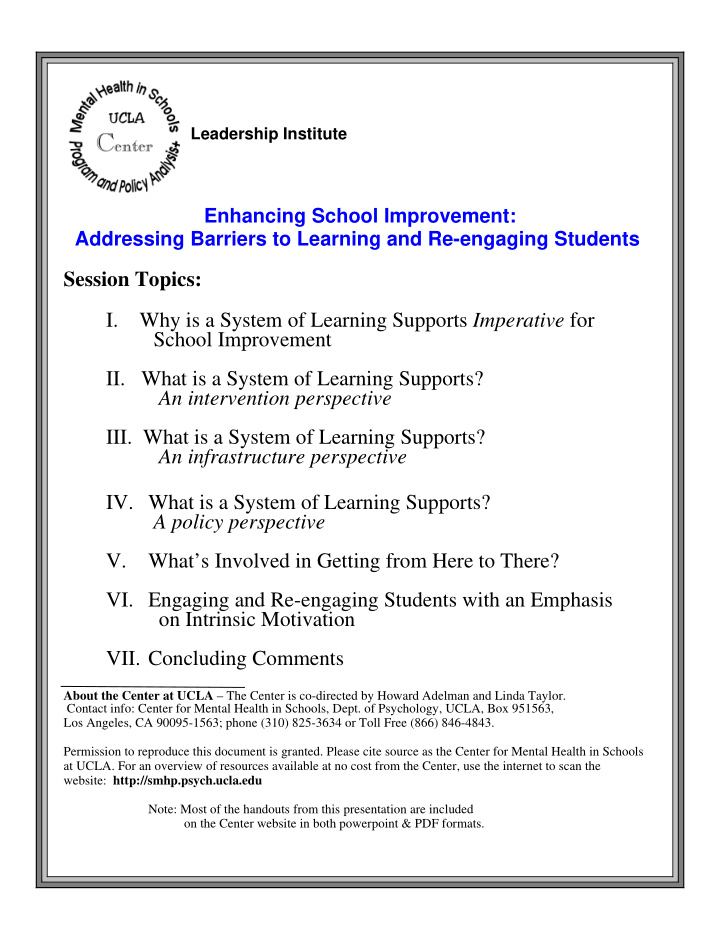



Leadership Institute Enhancing School Improvement: Addressing Barriers to Learning and Re-engaging Students Session Topics: I. Why is a System of Learning Supports Imperative for School Improvement II. What is a System of Learning Supports? An intervention perspective III. What is a System of Learning Supports? An infrastructure perspective IV. What is a System of Learning Supports? A policy perspective V. What’s Involved in Getting from Here to There? VI. Engaging and Re-engaging Students with an Emphasis on Intrinsic Motivation VII. Concluding Comments About the Center at UCLA – The Center is co-directed by Howard Adelman and Linda Taylor . Contact info: Center for Mental Health in Schools, Dept. of Psychology, UCLA, Box 951563, Los Angeles, CA 90095-1563; phone (310) 825-3634 or Toll Free (866) 846-4843. Permission to reproduce this document is granted. Please cite source as the Center for Mental Health in Schools at UCLA. For an overview of resources available at no cost from the Center, use the internet to scan the website: http://smhp.psych.ucla.edu Note: Most of the handouts from this presentation are included on the Center website in both powerpoint & PDF formats.
Session I Why is a System of Learning Supports Imperative for School Improvement? >Some Major Concerns >Lenses for viewing school improvement efforts >School improvement planning: What’s being done & what’s missing?
Why is a System of Learning Supports Imperative for School Improvement? Some Major Concerns Teachers shouldn’t be expected to, never mind being held accountable for, doing it alone! The current focus of school improvement policy and practice is too limited to ensure that all students have an equal opportunity to succeed at school. The limited focus contributes to: C High Student Dropout Rates C High Teacher Dropout Rates C Continuing Achievement Gap C So Many Schools Designated as Low Performing C High Stakes Testing Taking its Toll on Students C Plateau Effect
<><><><><><><><><><><><><><> Data from the National Assessment of Education Progress (NAEP) clearly shows the plateau effect related to academic achievement <><><><><><><><><><><><><><>
The Nation’s Report Card – National Center for Education Statistics Trend in NAEP reading average scores for 9-year-old students Trend in NAEP reading average scores for 13-year-old students See key on next slide
The Nation’s Report Card – National Center for Education Statistics Trend in NAEP reading average scores for 17-year-old students * Significantly different ( p < .05) from 2008. Key Original Assessment Format Revised Assessment Format See note below Note: The long-term trend assessment was updated in several ways in 2004. Outdated material was replaced, accommodations for students with disabilities (SD) and for English language learners (ELL) were allowed, and administration procedures were modified. A special bridge study was conducted in 2004 to evaluate the effects of these changes on the trend lines. The study involved administering both the original and revised formats of the assessments to determine how the revisions may have affected the results.
Why is a System of Learning Supports Imperative for School Improvement? <><><><><><><><><><><><><><> Three Lenses for viewing school improvement efforts <><><><><><><><><><><><><><> Lens #1 = ALL Students Not some – ALL youngsters are to have an equal opportunity to succeed at school
Range of Learners (categorized in terms of their response to academic instruction) I = Motivationally ready and able* II = Not very motivated/ Lacking prerequisite knowledge & skills/ Different learning rates and styles/ Minor vulnerabilities** III = Avoidant/ Very deficient in current capabilities/ Has a disability Major health problems *Few youngsters start out with internal problems that interfere with learning what schools teach. There can be little doubt that external factors are primarily responsible for the majority of learning, behavior, and emotional problems encountered in schools. **All learners have assets/strengths/protective factors that can contribute to success; all have differences that require some degree of personalization by instructional systems; any may internalize negative experiences that interfere with learning at school.
Lens # 2 = Barriers to Learning Barriers to Learning and School Improvement Range of Learners (categorized in terms of their response to academic instruction at any given point in time) I = Motivationally ready & able No barriers Instructional Not very Component Desired motivated/ Outcomes lacking Classroom (High Expect. prerequisite Barriers Teaching & knowledge to + Accountability) II = & skills/ learning, Enrichment different develop., Activity learning rates teaching & styles/ (High Standards) minor vulnerabilities III = Avoidant/ very deficient in current capabilities/ has a disability/ major health problems *Examples of Risk-Producing Conditions that Can be Barriers to Learning E n v i r o n m e n t a l C o n d i t i o n s** Person Factors ** Neighborhood Family School and Peers Individual >extreme economic deprivation >chronic poverty >poor quality school >medical problems >community disorganization, >conflict/disruptions/violence >negative encounters with >low birth weight/ including high levels of >substance abuse teachers neurodevelopmental delay mobility >models problem behavior >negative encounters with >psychophysiological >violence, drugs, etc. >abusive caretaking peers &/or inappropriate problems >minority and/or immigrant >inadequate provision for peer models >difficult temperament & status quality child care adjustment problems >inadequate nutrition **A reciprocal determinist view of behavior recognizes the interplay of environment and person variables .
Caution: Don’t misinterpret the term • Barriers to Learning It encompasses much more than a deficit model of students. And, it is part of a holistic approach that emphasizes the importance of • Protective Buffers (e.g., strengths, assets, resiliency, accommodations) and • Promoting Full Development
Recommend
More recommend